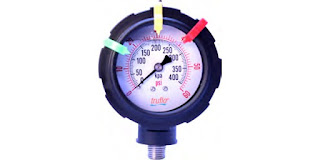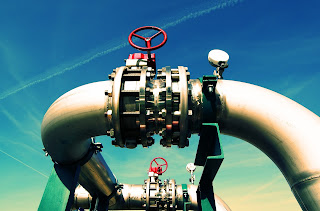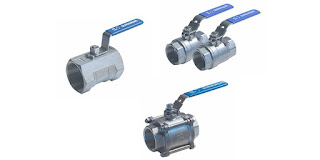 |
Model TD2 Thermal Dispersion Flow Switch
Image courtesy Magnetrol |
Thermal dispersion flow switches use an operating principle similar to that of a thermal mass flow meter. Moving fluid carries heat away from the probe tip reducing the temperature difference between a heated resistance temperature detector (RTD) and a reference RTD. Unlike a flow meter, a thermal dispersion switch operates with setpoints, comparing the detected flow rate to the setpoints and controlling a relay or other digital output in response. Manufacturers will refer to the switch being in “alarm” at set point. How the relay is wired (NC-CO or NO-CO) depends on the needs of the application.
High or low flows can be detected by thermal dispersion switches. While thermal dispersion flow measurement technology is applicable for gases and liquids, pump protection is the subject of this post, and reference will be limited to liquid flows and low flow detection.
Running pumps with inadequate liquid throughput is well recognized as a source of excessive wear, parts damage, cavitation and downtime due to repair. The cost of replacement parts, repair labor and lost production time can ramp up very quickly.
Monitoring liquid flow rate and triggering an alarm or pump shutdown to prevent damage has substantial benefit, even in a system of comparatively modest size.
There are many technologies that can measure liquid flow and function as part of a pump protection scheme. Flow meters can be used, but a continuous flow measurement may not be needed for the application. Flow meters typically are more costly than flow switches.
Mechanical flow switches are an alternative. Prior to the availability of electronic controls, they were generally the only method employed. They use a mechanical operator, driven by liquid flow, to actuate a relay. Typically, a vane or paddle is in the flow stream and swings in the direction of the flow. When the vane moves a predetermined distance, a magnetic sleeve or other device rises to draw the magnet in to actuate the switch. Moving parts are subject to wear, possible jamming and increased maintenance over time. Viscous liquids or those that may accumulate deposits on the operating mechanism can decrease reliability of the switch. A mechanical flow switch may be desirable if there is limited on-site power. In terms of the installation, the pipeline must be horizontal.
Vibrating forks and ultrasonic gap switches are other technologies employed for pump protection. It is inherent in these technologies that the presence or absence of liquid at the sensor location is all that is detected, not actual fluid flow. They are unable to detect decreasing flow rates, and their "gap" at the sensor creates opportunity for plugging or fouling with some liquids. Common applications for these switches are sumps or wet wells. Dual ultrasonic gap switches have pump control modes where the unit performs auto-fill or auto-empty as needed.
Thermal dispersion flow switches deliver a robust feature set and application flexibility.
- No moving parts
- Low maintenance burden
- Range of probe types to accommodate water or more viscous liquids
- Installation in horizontal or vertical lines
- Variety of mounting types and insertion locations
- Optional remote mount electronics
- Hot tap options available
- Low flow detection as opposed to dry pipe
- Current output for trending and fault indication
- Temperature compensation to reduce set point drift under varying operating temperatures
Probe Types
The standard probe design offered by thermal dispersion switch manufacturers is a twin tip construction to house the sensors. The twin tip is essentially two tubes welded to the end of the probe that are in the process liquid.
Twin tip probes can be beneficial as multiple manufacturers have similar designs. It has a very high pressure rating and is available in a variety of construction materials.
A unique design that may be preferred for liquid applications is the spherical tip probe. The lack of pins at the end of the probe eliminates plugging in viscous applications while the thin wall allows increased sensitivity with the process liquid. With pressure ratings up to 600 psig (41 bar) and standard 316 stainless steel material of construction it is suitable for most pump applications.
Electronics
The electronics for the thermal dispersion switch can be integral to the probe assembly or remotely located, enclosed in an explosion proof or other suitable housing. Wiring is simplified with the terminals easily accessible without removal of the bezel or any circuit boards. Along with the ease of installation come many diagnostic features incorporated in the microprocessor based electronics.
A useful diagnostic feature in the electronics is the current output. It is not a linear 4-20 mA output, similar to a flow meter, but the current will act as a live signal that varies with heat transfer. For example, in a low flow condition the current may be 8 mA and at normal flows 12 mA (output varies for each application). The current will be repeatable for a given low flow set point. If there is turbulence in the line, possibly being caused by a closed valve with the pump still running, the sensor will see this turbulence as a higher flow rate than what is actually occurring. The live signal allows the operator to monitor conditions to which the sensor is exposed and possibly develop custom diagnostics for the fluid system.
Along with the trending capabilities of using the current output, this output will also go low or high when a fault condition occurs according to NAMUR NE 43. For pump applications where a low flow alarm is desirable, the current will fall to less than or equal to 3.6 mA during the fault. The microprocessor based electronics monitor for any open circuits or flow signal that goes out of range. Without a microprocessor, the flow switch could be subject to more noise, have drift issues and need more frequent calibration to maintain the set point.
The user also has the option to select a window in the housing of the electronics. This window allows viewing of the LEDs to show normal operation (relay energized), alarm/set point (relay de-energized) and fault conditions (relay de-energized). Switch and process operation can be confirmed locally at a glance.
Because the principal of operation of thermal dispersion switches is temperature dependent, temperature compensation is provided in the electronics circuitry. Temperature compensation will reduce set point drift under varying operating temperatures.
Pump Installations
Both positive displacement and centrifugal pumps have performance curves to maximize efficiency. There is an ideal combination of differential head and flow rate that will provide the best results. If monitoring the differential head, a thermal switch can be set up to shut the pump down when it is operating below the ideal flow rates. Worst case scenario, the thermal switch is installed to verify there is liquid flow to prevent excessive wear or failure.
Installing the thermal switch in either the suction or discharge piping is acceptable. It is important to install in a location where the sensor tip will be exposed to liquid movement, especially in the case of a partially filled pipe. When field calibrated, which is most often the case for thermal switches, it is not necessary to install at the centerline of the pipe. As long as the probe is far enough into the pipe to see liquid movement, it will provide repeatability at the given flow rate. A quarter to half way into the pipe is common.
Installing a few diameters away from the pump will reduce the impact of excess turbulence. Turbulence may cause the switch to sense higher flow rates than what is actually occurring inside of the pipe. Movement of liquid due to turbulence can theoretically create as much heat transfer as the liquid flow itself. The aforementioned current output is a helpful diagnostic feature in more difficult installations.
Summary
Thermal dispersion switches are used in pump protection applications ranging from standard water to high viscosity liquids. There are unique sensor designs for each individual application, including the popular spherical tip, low flow bodies and high temperature/pressure probes. The multitude of probes in conjunction with the advanced electronics make thermal dispersion switches a competitive technology for pump protection.
Share your fluid flow challenges with
process measurement specialists. Leverage your own knowledge and experience with their product application expertise to develop effective solutions.





